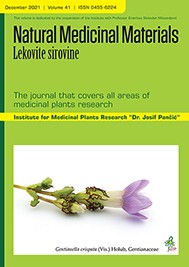Department of Biology and Ecology, Faculty of Sciences and Mathematics, University of Nis , Niš , Serbia
Institute for Medicinal Plant Research “Dr. Josif Pančić” , Belgrade , Serbia
Institute for Medicinal Plant Research “Dr. Josif Pančić” , Belgrade , Serbia
Department of Pharmacy, Faculty of Medicine, University of Nis , Niš , Serbia
Faculty of Science and Mathematics, University of Priština temporarily settled in Kosovska Mitrovica , Priština , Serbia
Department of Pharmacy, Faculty of Medicine, University of Nis , Niš , Serbia
The paper provides an insight into the traditional use of medicinal plant species from the genus Gentiana in the Pirot County in Southeastern Serbia. The ethnopharmacological study was conducted in the form of interviews among the population in four municipalities: Pirot, Babušnica, Bela Palanka, and Dimitrovgrad. Among the population of Pirot County, it was noticed the use of two species from the genus Gentiana: G. cruciata and G. lutea. It was recorded that cross gentian (G. cruciata) has great popularity and versatile aspects on traditional usage, that was mentioned by 53 respondents, and that includes the treatment of cancer diseases, improving the immune system, diabetes, blood purification, for appetite, gastric and duodenal ulcer, for high blood pressure, inflammation, lung diseases, cold, cough, disease prevention, diseases of internal organs, high cholesterol, and leaking breast. The usage of the root of yellow gentian (G. lutea) was mentioned by 30 respondents, and that includes improving the immune system, appetite, for the stomach, blood purification, circulation, as an aphrodisiac, against cancer diseases, diabetes, and gastric and duodenal ulcer. It is important to note that yellow gentian, recorded in the study area, is the first species on the list of illegally collected species in Serbia.
This is an open access article distributed under the Creative Commons Attribution License which permits unrestricted use, distribution, and reproduction in any medium, provided the original work is properly cited.

The statements, opinions and data contained in the journal are solely those of the individual authors and contributors and not of the publisher and the editor(s). We stay neutral with regard to jurisdictional claims in published maps and institutional affiliations.